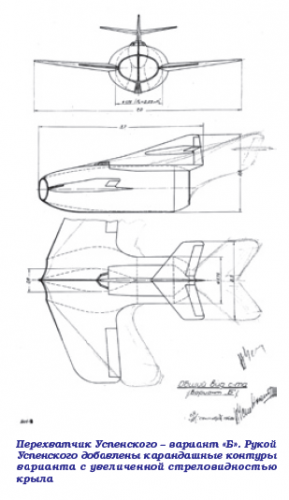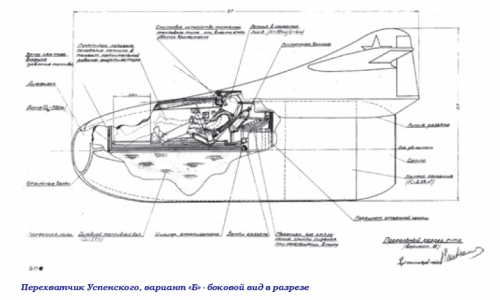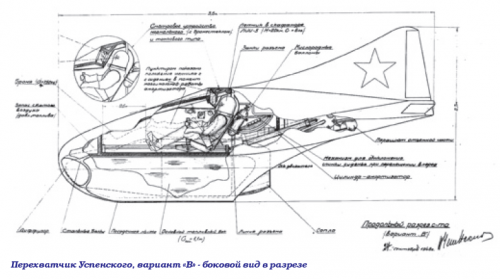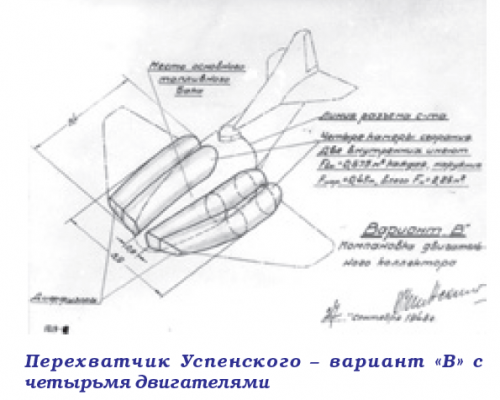You are using an out of date browser. It may not display this or other websites correctly.
You should upgrade or use an alternative browser.
You should upgrade or use an alternative browser.
Interceptor/Fighter designed by V.N. Uspensky
- Thread starter Antonio
- Start date
- Joined
- 26 May 2006
- Messages
- 32,779
- Reaction score
- 12,052
OK my dear Pometablava,
it was called Interceptor/Fighter designed by V.N. Uspensky,and here is the translation;
it was called Interceptor/Fighter designed by V.N. Uspensky,and here is the translation;
Taran - WEAPON interceptors
(Fighter project V.N.Uspenskogo)
Sergey Komissarov,
deputy chief editor of "KR"
By 1948, fighter jets, equipped with
TRD, firmly taken its place in military aviation
leading aviation powers. In the USSR, 1948 was a year
the introduction of a series of famous MiG-15. This
aircraft, together with the equally famous opponent in
the face of the American F-86 "Sabre", asked, if I may
say, the tone in the further development of fighter
aircraft. Fighters - not only front-line, but also other
purposes - should have, along with great speed,
have sufficient range and duration
flight and carry a powerful gunnery, and then
Missiles. Attempts to create a fighter-
interceptors with rocket engine, designed to protect
"Point" objects and has a very limited
chennoy range and residence time in the air, not
It paid off - this way turned out to be a dead end. None
However, at that time it was carried out by different designers
development of jet fighters very neordi-
tionary schemes. One such project and referred to in this
article.
In July and October 1948 FRI Fellow them. Gromov
Engineer V.N.Uspensky developed and proposed origi-
tional project a jet fighter-interceptor,
deprived of cannon armament. According to the author
project efficiency cannon armament in combat with
modern high-speed bomber was
very low due to difficulties with aiming.
Instead of guns Assumption offered to make weapons
fighter ram, which, in his opinion, provided
Assured Destruction goal. In order to
protect the fighter pilot and possibly
maintain the aircraft after the ramming, the Assumption
I offered to make a fighter nose of the massive and
very strong and ensure the effective reservation
cockpit armor weighs 500-700 kg (while
he noted, single fighter had weight armor
about 100 kg, that "in caliber may be advanced
only a symbolic value "). At the same armor to the maximum
mum degree should be an element of strength airframe.
Interceptor had to start with a gentle ramp
using the accelerator (possibly solid fuel)
and dispersed in the horizontal section up to speed
115 m / sec., Then switched boosters,
accelerator aircraft dumped and passed to a set of
height by almost vertical trajectory (as is evident from
drawing, placed in the submitted explanatory
note). And provides an alternative option
launch aircraft from the start of the well.
Author of the project argued that the proposed
Interceptor will provide a 100% loss goals,
being himself very malouyazvim. Reservations, superior to
Catching up 6-7 times the weight of a conventional fighter armor
was, according to him, to withstand frontal
hit projectiles caliber 57 mm. Interceptor was
designed for strikes and the destruction of the aircraft to its target
heavy and rugged, in the presence of protective and
antigravity devices in the pilot. "These
in simple devices note, including the entire department
cab with feathers, provide a pilot to safety
when out of combat (...). " "The proposed interceptor
will have large enough effective
intercept radius and provide the Dogon and attack aircraft
opponent with speed up to 1000 km / h and altitude
up to 11 thous. m. " The authors conclude his note with the words: "...
The proposed interceptor is not intended to
replace the existing air defense systems and, especially,
continuously improved fighter
aircraft having gunnery armament.
At the same time, it can certainly be very
additional effective weapon to repel
air attack of the enemy. "
The author of the project prepared by an explanatory
note there are several versions of drawings predla-
Guy them interceptor. In all cases
very compact machine normal aerodynamic
scheme, but rather a kind of form. All plane
wing and tail have a leading edge sweep
straight and trailing edges, wing has a small elongation.
Figures labeled version of the "B" (option "A"
no document) shows an arrangement in which
very short and thick fuselage, similar to the barrel,
It is essentially entirely engine nozzle
large diameter (straight-through?), but cockpit
inscribed in the contours of the engine nacelle. on the top
side of the fuselage, the engine is strelo-
prominent cruciform tail unit circuit. Wing
sredneraspolozhennoe in this embodiment, has moderate
sweep of the leading edge and a straight back
edge. Wingspan of only 7.0 mm and a length
plane - 5.7 mm. Frontal air intake razdvai-
INDICATES in the air ducts, the envelopes on the sides of the cabin. AT
other configurations of the same version of the wing given a
increased sweep, empennage
He handed back the bleed nozzle.
Figure another embodiment (denoted as
option "B") shows a perspective plane with four
(!) Jet engines unknown (does not exist
the guide?) type, placed in the wing roots
pairwise on both sides of the fuselage, as in aircraft De
Havilland Comet or at myasischevskogo M-4, with air intake
nicknames in the wing root. Option "B" presented
also layout drawing of the side view. Unlike
from the previous figure, on it is viewed razdvo-
enny nose air intake, each of which,
probably feeds his mate motors adjacent
fuselage to left and right (in the figure is only visible
the inner right engine). Aft fuselage
reminiscent of aircraft hull steps schemes and carries horizontal
tal tail.
From these design patterns can be learned
some additional information. For cabin
constructed as shown bronekorobki. Pilot
shown dressed in suit FRI-5, calculated
on the flight altitude of 20 km (which indicates the altitude
airplane); its seat can be moved forward
to give the pilot to the horizontal position
"At the moment of maximum performance absorber" (at
planting?). canopy itself is not, except
visor with minimal glazing. Overview forward
provided through the viewing device with armored
glass or by using the periscope device
like a tank. In both cases, the field of view
It obtained obviously very limited. The edges of the air-
intake and adjacent to the front part of the fuselage
edge of the wing are made of steel beams calculation
bear at the time of ramming. In the drawing,
as a power structure element contains
ski, apparently replacing a conventional chassis.
It was noted the presence of a parachute to save the pilot in
detachable part of the aircraft.
The above information is set out in
document, which is entitled "to the project Guards
interceptor. Part first. Ob'yasnitelnaya note author.
Constr., Ing. V.N.USPENSKY July-October 1948 ". On
the front page of the Assumption is written by hand: "Material
Preliminary requires revision ... ".
Unfortunately, the description of the project is very affordable
incomplete. The existing note is no information on
power plant, on the projected flight characteristics
tics, on the order of exit from the battlefield after the ramming of the process
and landing on the landing gear, and much more.
Apparently, the degree of detail of the project is that it
It should rather be regarded as a technical proposal. But
and from the above it is clear that the author offers
Project method of destroying enemy bombardment
ers was conjugate with a greater risk for the pilot and
actually turned into a means of intercepting disposable
zovogo application. It can be assumed that the project
summoned at least skepticism.
Anyway, it has not received stroke.
Perhaps, it can be considered comparable for the exotic
appeared around the same time in the Yakovlev Design Bureau
Projects interceptor Yak-40 and Yak-40A. The Yak-40 is
a single-seat fighter with two ramjet at the ends
swept (45 °) of the wing. Plane with 2 guns in the nose
the fuselage had a wingspan of 5.05 m, length 7.50 m,
Flight weight of 1800 kg. Take-off was carried out using
propellant boosters mounted on detachable
trolley. Studies of the Yak-40 and Yak-40A
(Different setting accelerators are not on the trolley,
and under the wing.) were carried out in January-June 1948 was
and the option of placing the Yak-40 fighter jets in the amount of
six pieces under the wing of the aircraft carrier Tu-4.
Attachments
Similar threads
-
New Fonthill Book - Rocket Interceptors 1941-1947
- Started by Justo Miranda
- Replies: 2
-
German Panic Fighters- Emergency Fighter Programs 1944-1945
- Started by Justo Miranda
- Replies: 16
-
-
-




